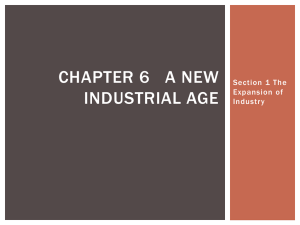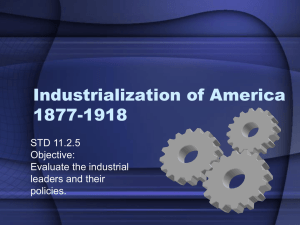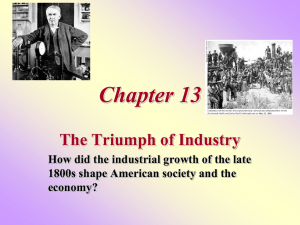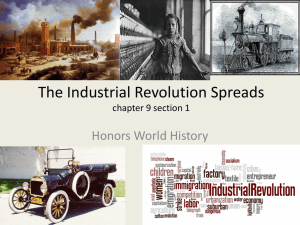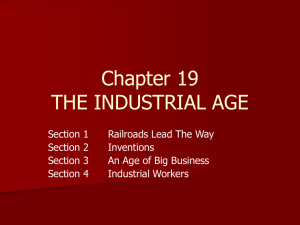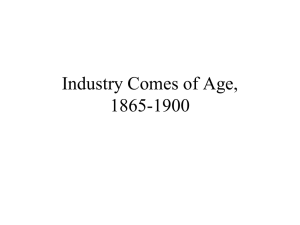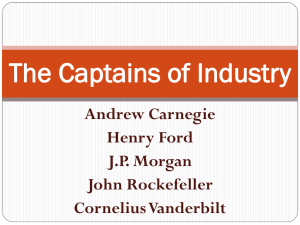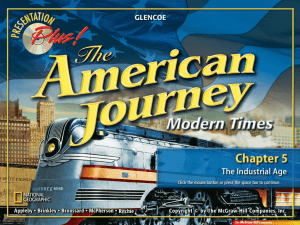Industrialization Power Point for modern U.S. Teacher
advertisement
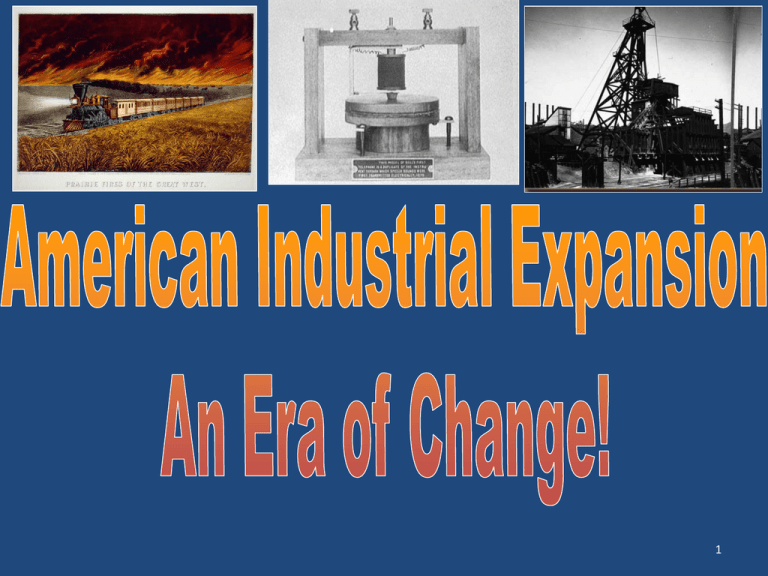
1 Background • Industrialization = the process by which production shifts from simple hand tools to complex machines. • Traditional or Pre-Industrial Society – Self-sufficient towns (traditional economy) • • • • People lived and worked in villages Farms supplied the food Family made household items (soap, candles, furniture) Local craftsmen made utilities (blacksmiths, shoemakers, tailors) • Small stores provided rare items (gunpowder, coffee, tea) Background • Causes of Industrialization – The Agricultural Revolution • New Farming Innovations eliminated the need for farmers and forced many to move to cities to find jobs. – (seed drill, steel plow, crop rotation, fertilizer) • Improved farming efficiency = increased food supply = increase in the population. – Great Britain was the first to industrialize because it had… • Abundant resources, a large workforce, stable economy and government, advanced technology. Number of man-hours to produce crop 700 600 500 Wheat 100 bushels Corn 100 bushels Cotton bale 400 300 200 100 0 1800 1840 1860 1900 4 Increase in amount of agricultural products produced on farms, 1850-1900 45 40 35 30 25 Farm Output 20 15 10 5 0 1850 1860 1870 1880 1890 1900 5 Background • The First Industrial Revolution (Early 1800s) – Forged by iron – Powered by steam – Driven by the textile industry in England – By the mid-1800s the industrial revolution spread outside of Great Britain into Western Europe and the United States. • These countries, especially the U.S., industrialize very quickly – Why? % of world manufacturing by nations 1870-1913. “Other Nations” means every other country in the world combined. 40 35 30 25 Great Britain Germany U.S. Other Nations 20 15 10 5 0 1870 1900 1913 7 Expansion of Industry in the U.S. • After the Civil War the U.S. was still largely an agricultural nation. • However, rapid industrialization took place in the late 1800s- early 1900s due to… – Abundance of natural resources – Government support for business – Growing urban population Expansion of Industry in the U.S. • The Oil Boom – 1859 Edwin L. Drake used a steam engine to drill for oil in Pennsylvania = oil boom. • Oil boom spread to Kentucky, Illinois, Indiana , Ohio, and Texas – Petroleum refinery industries arose in Cleveland and Pittsburgh. • Turned oil into kerosene – Gasoline, a byproduct of the refining process, was not considered valuable/useful until the invention of the automobile. Expansion of Industry in the U.S. • Bessemer Steel Process – Iron was the dominant building material of the early industrial era but it was soft and broke easily. – Steel – British engineer Henry Bessemer developed a process of purifying iron ore to produce a new substance = steel – Steel was lighter, harder, more durable, and cheaper than iron – Steel became the major material used in tools, bridges, railroads, farm machines, skyscrapers – industrialized countries measured their success in steel output. The process for making steel was discovered thousands of years ago Although steel was superior to iron it was much harder to make and did not become widespread until the second half of the 19th century. Many people tried to find a way to produce steel cheaper but it was Henry Bessemer, an English industrialist, who first devised what became known as the “Bessemer process” for making cheap steel. 11 Steel Production in millions of tons 35 30 25 France Germany Great Britain U.S.A. 20 15 10 5 0 1913 13 Expansion of Industry in the U.S. • The Power of Electricity – 1876 Thomas Edison established the world’s first research laboratory in New Jersey. • 1880 – patented the light bulb • Developed an entire system for producing and distributing electrical power. – Significant effects/uses of electricity … • • • • • Ran powerful machines Invention of time-saving appliances Improved travel = outward spread of cities Manufacturers could build a factory anywhere Businesses could operate around the clock Thomas Alva Edison (18471931) was one of the most productive and creative inventors in history. He was also a shrewd businessman, manufacturing and marketing many of his inventions and innovations. Edison’s voice, 1888 15 Expansion of Industry in the U.S. • Inventions Change Lifestyles – 1867- typewriter (Christopher Sholes) – 1876 – telephone (Alexander Graham Bell) – These inventions affected office work, improved communication, and created new jobs for women. 1889 ad to train secretaries 1885 ad for Remington typewriters 17 Growth in telephones 1876-1900 (in thousands) 1400 1200 1000 800 600 400 200 0 1876 1880 1885 1890 1895 1900 19 Expansion of Industry in the U.S. • Move to Factory Labor and Industrial Job Growth – The invention of interchangeable parts made factory work faster and more efficient • Individual parts on machines could be replaced instead of having to buy a whole new machine (interchangeable parts) – People were sick of farm labor and the new technology created the MYTH that factory work was easy. – People desired a shorter work day – People wanted to earn a wage – daily pay • A guaranteed daily pay never existed before – Attracted immigrants desperate for jobs to industrial cities As the Industrial Revolution got underway, it triggered a chain reaction: Growing demand for goods = Inventors developing new machines to produce large quantities of goods more efficiently = Supply of goods increases = Prices fall =More consumers can now afford the goods= Further demand for goods = changes in how people live** The Age of Railroads • Growth of the Railroad – railroads drastically changed business and the lives of the American people. • May 10, 1869 – the Transcontinental Railroad was complete, connecting the U.S. coast to coast. – 1890 - nearly 180,000 miles of track in the U.S. – Western products like agriculture, coal, and other minerals could be moved easily to the east coast. – Passengers and freight from the east coast could reach the west coast in a matter of days instead of months at cheap prices. – Many people began settling in western areas. – Building this track was dangerous, difficult work. Meeting of the Union Pacific and Central Pacific at Promontory Mountain in southern Utah in 1869 25 Railroad track mileage increased at a rapid pace from 1830 to 1910 (United States) 250000 200000 150000 100000 50000 0 1830 1850 1860 1870 1880 Miles of track 1890 1900 1910 27 Chinese laborers Building the railroad was extremely difficult labor done mostly by hand. Rail beds were created with pickaxes, hammers, and crowbars. Dirt and rock had to be carried away in baskets and carts. Tree stumps were rooted out, tracks laid, spikes driven, aqueducts and tunnels constructed. The ridges in the Sierra Nevada mountains, where tracks had to be laid, were 2,000 feet above the valley. Chinese laborers were lowered in baskets to hammer at solid shale and granite and insert dynamite. Much of the work on this passage was completed during the winter of 1865-1866, by 3,000 workers who lived and worked in tunnels dug beneath 40-foot snowdrifts. Accidents, avalanches, and explosions left an estimated 1,200 Chinese immigrant workers dead. 28 The Age of Railroads • Uniting the Nation – The railroad united the diverse regions of the country HOWEVER, each community still operated on its own time. – Solution = Time Zones • Professor C.F. Dowd suggested dividing the earth into 24 times zones (one for each hour of the day). • The U.S. would contain 4 time zones. • November 18, 1883 railroad crews synchronized their watches. • “Railroad time “ however was not used by all Americans until 1918 when Congress adopted it as the standard. Gauge George Westinghouse created a better braking system based on compressed air which revolutionized the train industry Four standardized time zones replaced the original 100 on November 18, 1883, which made scheduling much easier 30 Operation of railroads depended on the use of the telegraph to communicate location and prevent collisions 31 The Age of Railroads • New Towns and Markets – Railroad promoted trade and interdependence by linking towns. – Individual towns began to specialize in particular products. • Ex. Chicago became known for its stockyards – New towns grew along the railroad lines. The Age of Railroads • New Towns and Markets - continued – 1880 George Pullman built a factory for manufacturing sleepers and other railroad cars in Illinois. – The Pullman town developed around this factory for the employees of the factory. • Employees were provided clean, well-constructed homes as well as other services and facilities. • However, Pullman strictly controlled his employees believing this would create a stable workforce. • Eventually his employees will strike! George Pullman designed a sleeping car including the services of supplying the linens, housekeeping, and attendants for the sleeping cars, making train travel much more comfortable. Pullman’s car gained much attention after it housed President’s Lincoln’s body through 8 states during the funeral procession. 34 The Age of Railroads • Railroad Abuses – Farmers grew angry at the railroad companies b/c… • The RR companies misused government land grants by selling land to other business instead of settlers. • RRs charged different customers different rates. – Farmers took action… • 1867 - Formed the Grange, a farmer’s organization , and began demanding governmental control over the railroad industry. Pacific Railway Acts In 1862 and 1864 the federal government passed the Pacific Railway Acts. These two acts permitted the government to make grants of public land to private corporations for the construction of a trans-continental railroad. The grants stipulated that for every mile of track laid, the government would grant to private railroad corporations 20 sections of public land (12,800 acres). In addition to the land grants the government guaranteed a payment of $48,000 for every mile of track built in mountainous terrain and promised low interest loans. 37 The Age of Railroads • Early Railroad Regulation – The Grangers were successful in getting legislation passed to regulate the railroad industry. – Interstate Commerce Act of 1887 – established the right of the federal government to supervise railroad activities . However, this commission didn’t have any real power until the early 1900s. Big Business and Labor • The Rise of Big Business – New technologies required investments of large amounts of money – To get the money business owners sold stock = shares of companies to investors. – By the late 1800s “Big Business” came to dominate industry. • Large-scale companies sold hundreds of thousands of shares to form corporations = businesses owned by many investors who buy shares of stock and risk only the amount of $ they invest in the company. Big Business and Labor • The Rise of Big Business – Powerful business leaders created monopolies or trusts = huge corporate structures that control entire industries or areas of the economy. – In pursuit of profit, business leaders destroyed competition. • With competition gone they were free to raise prices and control the market! Big Business and Labor • New Business Strategies – Vertical integration - The process in which several steps in the production and/or distribution of a product or service are controlled by a single company. – Horizontal integration – when companies producing similar products merge. Wealthy business leaders in the 19th century were glamorized or villanized One view glorified their abilities and contributions 1. "Captains of Industry” Industrial leaders were viewed as ingenious and industrious capitalists who transformed the American economy with their business skills. These "Captains" were the heroes of their day who embodied the American dream of rags to riches. A second view questioned their tactics and ethics 2. "Robber Barons” Industrial leaders were viewed as immoral, greedy, and corrupt, using bribery, illegal business practices, and cruelty to workers to get ahead. Many of the most respected industrialists were also feared and hated. While not all of these men were unethical, many used questionable tactics to achieve their goals of wealth and power. 43 Robber Barons Robber Baron is an insult term used to describe a class of enormously rich businessmen that emerged in the post civil war era. Today they would be known as billionaires. They were both admired and hated at the time. They used ruthless, unscrupulous, and often illegal methods to create monopolies and develop overwhelming economic power and control over their industries. In the late 1800’s a handful of these businessmen controlled over 90 percent of total U.S. wealth. Some of the more commonly known industrial leaders and bankers who were called Robber Barons include: Andrew Carnegie 300 John D. Rockefeller 250 Cornelius and William Vanderbilt 200 Jay Gould J. Pierpont Morgan Jim Fisk Daniel Drew 279 1865 1900 2004 150 100 50 0 3 22 Total number of billionaires 44 Chart shows the comparison in the number of billionaires from 1865 through 2004 Big Business and Labor • Famous “trusts” and “robber barons” – John D. Rockefeller’s Standard Oil Company dominated the oil industry through horizontal integration(mergers with competing companies ) and by 1890 he controlled 90% of the Oil industry. – (Rockefeller became the richest man in the world and the first U.S. Billionaire. He was worth $257 billion by today’s standards. Rockefeller gave away $500 million to fund universities and medical institutes ) 46 Big Business and Labor • Background: Famous “trusts” and “robber barons” – cont. - Andrew Carnegie dominated the steel industry by buying out his suppliers and owning all aspects of the production process (vertical integration) and buying out competing steel producers (horizontal integration). - (Carnegie was a philanthropist and donated about 90% of his wealth to fund public libraries, scholarships and other charities.) How rich were the “robber barons” compared to Microsoft founder Bill Gates? 200 180 160 140 120 100 80 60 40 20 0 Rockefeller Carnegie Vanderbilt Bill Gates Jay Gould JP Morgan James H. Hill $ billions $ 48 The millions made by the robber barons is at the expense of the workers 49 Big Business and Labor • Social Darwinism – scientific explanation for the success of these wealthy business men. – Grew out of Charles Darwin’s theory of biological evolution - survival of the fittest. – Herbert Spencer used Darwin’s theory to explain the evolution of human society. – Economists used this theory to justify laissez faire economics – the belief that the economy should not be regulated by the government or anyone. Herbert Spencer “Social Darwinism” Spencer, an Englishman, was a philosopher who is best remembered for his ideas that have become known as “Social Darwinism”. Social Darwinism advocated laissez-faire capitalism, an economic system that allows businesses to operate with little government interference. Spencer believed that competition was “the law of life” and resulted in the “survival of the fittest”, a phrase he used years before Darwin. Spencer argued in his various writings that society is best served when its fittest members operate without opposition. Unlike Darwin, Spencer also believed that individuals genetically pass on their learned characteristics to their children. This meant the fittest persons inherited positive qualities such as intelligence, the desire to own property, and the ability to accumulate wealth. On the other hand, the unfit inherited laziness, stupidity, and immorality. “Each individual should be allowed to do as he or she wills as long as it doesn’t infringe on the rights of another person.” Spencer argued that the number of unfit would eventually disappear because of their inability to effectively compete with the fit. He was against any government aid to the poor because 51 it interrupted the correct evolution of civilization. Laissez faire ■Term originated in France during the Enlightenment ■Based on the idea that the government should not intervene in business or the economy; instead natural law or market forces would regulate ■Adam Smith popularized the term and concept in his book Wealth of Nations in 1776 ■This approach was embraced by industrialists during this era who did not want the government to regulate them in any way 52 Individualism The idea that a person should not rely upon others for success This philosophy was evident from the beginning of United States history Author Horatio Alger made this concept the theme of his books in which a poor young man is able to create wealth and success through his hard work Later the term “rugged individualism” becomes popular Horatio Alger 53 Big Business and Labor • Rise of Labor Unions: – Workers tried to improve the harsh conditions of industrial life through mutual-aid societies = selfhelp groups to aid sick or injured workers. – They were later called labor unions. – Why? Workers were Exploited • Long hours (12+ hour workdays, 6-7 days per week) • No vacation, sick leave, unemployment compensation, or reimbursement for injuries on the job • Hazardous working conditions • Low wages Big Business and Labor • Rise of Labor Unions - continued: – Biggest and Most influential Unions in the U.S. were … • National Labor Union (NLU), Knights of Labor, and American Federation of Labor – Goals: • Legalize the eight hour day, equal pay, settlement of disputes between workers and employers by an impartial person, higher wages, safety regulations,. – Collective bargaining – group negotiations to reach agreements between workers and employers Big Business and Labor • Rise of Labor Unions: – Labor Activism • Labor unions often organized strikes that resulted in violence and death. • The Haymarket Strike of 1886 – (wanted a shorter work day) – Police killed a striker at another plant the day before – In response, 1,200 people gathered at Haymarket Square in Chicago to protest – Someone threw a bomb from the crowd and a riot began – Police fired into the crowd – 7 police officers were killed and several rioters – 8 suspected strikers were arrested, 4 were hanged and one committed suicide in prison Big Business and Labor • Rise of Labor Unions: – Labor Activism • The Pullman Strike 1894 (wanted higher wages) –Pullman Railway Company laid off thousands of workers and cut wages during the economic panic of 1893 –Workers went on strike and set train cars on fire and fought police –Federal government got involved – sent troops to end the strike »Leaders were jailed, strikers fired and many workers were blacklisted Big Business and Labor • Rise of Labor Unions: – Labor Activism • Result – federal government had to get involved –union membership declined –union members fired –employees forced to sign “yellow dog” contracts – employees promise not to join a union . –People began to turn against the labor movement

